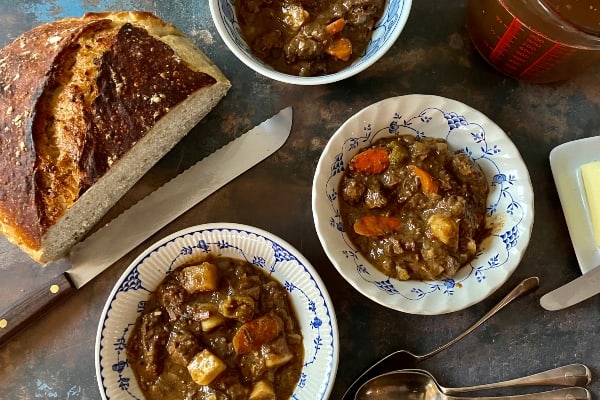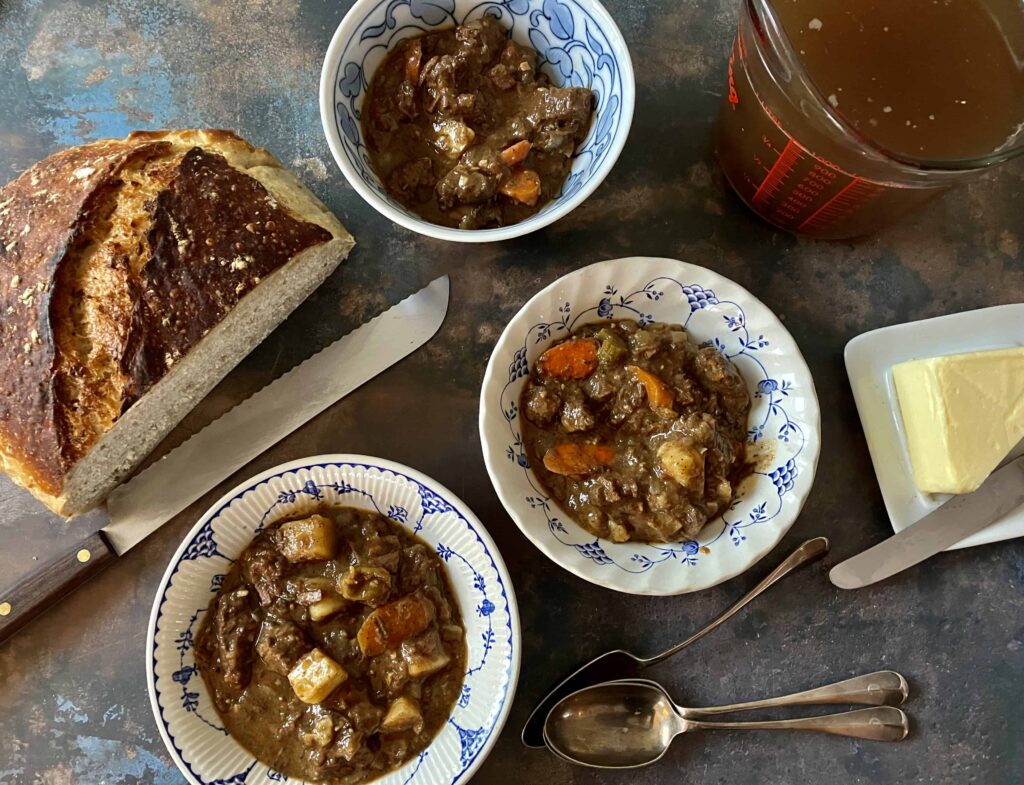The hunters are returning, the leaves have gone and there’s snow in them hills—it’s the season for big pots of stock simmering on the stove, filling the house with warm, delicious smells. And then, once the stock is ready, don’t you just crave a classic moose stew? Or moose bourguignon, or goulash, or French onion soup—at this time of year, we cooks say, “Hunters, bring back those bones!”

Moose Stew
Ingredients
- Moose Stock
- Ingredients
- 5 lbs moose bones
- 6 quarts water
- 1 pint red wine or pure apple juice
- 1 large onion, cut into eighths
- 2 large carrots, cut into quarters
- 2 stalks celery, with leaves, cut in half
- 5 bay leaves
- 10 black peppercorns
- 10 juniper berries, squashed to release flavour
- 1 star anise pod
- 1 Tbsp dried thyme
- 1 Tbsp dried rosemary
- Classic Moose Stew
- Ingredients
- 3 lbs moose stew meat, cleaned of gristle and silver skin, cut into 1-inch pieces
- 2 tsp rosemary
- 2 tsp tarragon
- 1 tsp kosher salt
- 1 tsp black pepper
- 4 Tbsp flour
- 1 Tbsp finely ground espresso
- 2 Tbsp olive oil (more as necessary)
- 2 Tbsp butter (more as necessary)
- 1 large onion
- 3 cloves garlic
- 4 medium tomatoes
- 4 cups moose stock
- 2 cups red wine or 1 3/4 cups pure apple juice and 1/4 cup apple cider vinegar
- Vegetables (to be added for last 45 minutes of cooking)
- 3 medium carrots
- 3 stalks celery
- 4 medium potatoes
- 2 Tbsp butter
- 2 Tbsp flour
- 1/2 cup red wine or pure apple juice
Notes
Preparation - Moose Stock
- Saw bones into pieces, as necessary, to fit your largest stock pot. Soak bones in cold water for 15 minutes, to remove impurities.
- Preheat oven to 400 F. Remove bones from pot, pat dry and arrange on a large baking tray and roast until browned, about 20 minutes. Add bones to the stock pot and pour in water—bones should be covered by at least 1 inch.
- Cover pot and turn burner to high heat. The water will take a while to boil.
- On the same pan you used to roast meat, arrange vegetable pieces. Toss to coat with any fat left in the pan.
- Roast until just browned, about 20 minutes. Set aside.
- Keep an eye on the pot of bones and skim off any scum that rises to the surface—as the water nears boiling, the scum will rise more rapidly. Keep skimming until you’ve removed as much as possible.
- Once the water is boiling and the liquid is as clear as you can get it (don’t sweat it too much), add the vegetables and all the seasonings. Bring to a boil once more and reduce heat to medium-low.
- Remove the cover. Simmer the pot for 8 hours (a wood stove is ideal for this task) until the stock has reduced by about 4 inches. *The aim is to have as slow a simmer as possible: that is, one large bubble just barely breaking the surface.
- Once stock is done, remove bones with a pair of tongs and place in a bowl. This will make pouring the stock through a strainer easier. (My dog loves the scraps of meat that come off the bones, with the fat removed. He would love the fat, too, but he is denied that treat for his own health, though he is not in agreement.)
- Pour stock through a strainer into several large bowls, to cool as rapidly as possible. (I put mine on the porch with a screen overtop.)
Once stock has cooled, skim off fat—save it if you think you will use it, or discard in the compost. Pour stock into containers with lids and freeze. Use in soups, stews, gravies, sauces, or just enjoy it on its own.
Preparation - Moose Stew
- Preheat oven to 300 F. Toss moose meat chunks with herbs and salt and pepper, using your hands to massage seasonings into meat. Whisk flour and espresso together, sprinkle overtop of the meat and toss again to thoroughly combine.
- Heat olive oil and butter in a large ovenproof casserole over medium heat. Once oil is shimmering, sauté meat in batches, turning once or twice so that it’s evenly browned. As each batch is finished, remove to a bowl and reserve.
- Once all the meat is cooked, add onion to the same pot and add more oil and butter if needed. Add a splash of red wine and stir to loosen any browned bits stuck to the pan.
- Sauté until onions are soft and translucent, about 7 minutes. Add garlic and cook for another 2 minutes.
- Return the meat to the pot, add stock and red wine and stir thoroughly to combine.
- Cover and bring to a simmer. Once simmering, transfer the pot to the oven and cook for 2 1/2 hours.
- While meat is cooking, prepare vegetables. Chop carrots, celery and potatoes into chunks about the same size as the meat. Heat oil and butter in a large frying pan over medium heat. Add all the vegetables to the pan and cook for about 5 minutes, just enough to soften the edges.
- Sprinkle flour overtop and stir to combine. Add red wine and stir—the liquid will thicken right away. Cook for 2 minutes, stirring constantly to prevent sticking. Remove pan from heat.
- Once meat has cooked for 2 1/2 hours, bring pot out of the oven, uncover and stir in the vegetables, getting right to the bottom of the pot to distribute evenly.
- Cover and return the pot to the oven. Cook for another 45 minutes until potatoes are tender. Taste and add more salt and pepper as necessary. If the sauce needs a little brightening, stir in a teaspoon of apple cider vinegar. Serve at once with some hearty sourdough bread, pasta or polenta.





